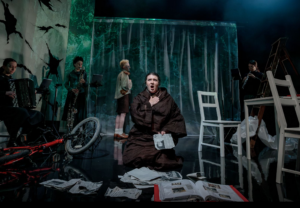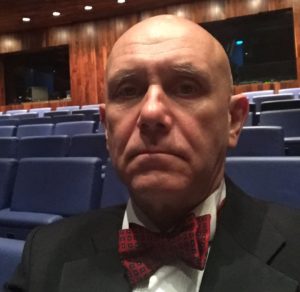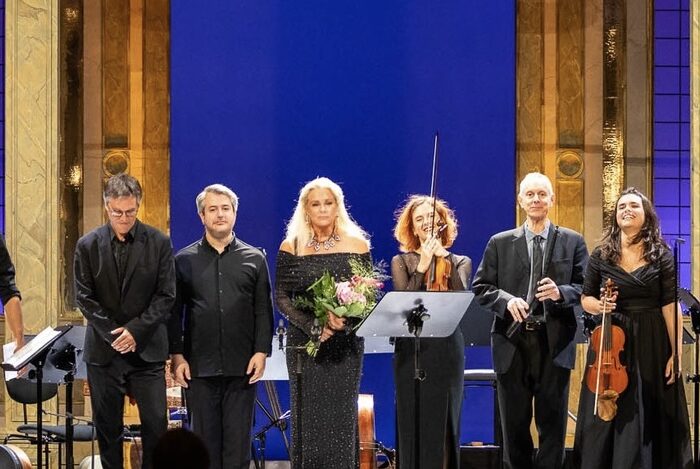
OperaUpClose 2025 Review: Riders To The Sea
Flora McIntosh Overseas An Imaginative Reinvention
By Alan Neilson(Photo: Rich Southgate)
Those members of the audience who were looking forward to OperaUpClose’s new production of Vaughan-Williams’ one-act opera, “Riders to the Sea,” or had been attracted by the chance of seeing a musical representation of J.M. Synge’s play of the same name, on which the opera is based and follows closely, may well have been somewhat surprised. The director, Flora McIntosh, in her program notes, talked of the production as an “opportunity for reinventing and reframing a classic work,” and this is exactly what was presented.
Instead of the usual sharply focused narrative compacted into approximately 40 minutes of theatre, the work was expanded into two parts, with additional music from composer Michael Betteridge and text from ArtfulScribe’s Community Sirens Collective, which increased the running time to 65 minutes and, in doing so, shifted the focus and tenor of the drama.
A Flawed Reinvention of the Narrative
Vaughan-Williams and Synge’s original work rotates around the figure of Maurya, who has already lost her husband, father-in-law, and several sons to the sea. She lives in a small community on an island off the Atlantic coast of Ireland with her two daughters, Cathleen and Nora, and two surviving sons, Michael and Bartley. Michael, however, never appears on stage as he has also drowned, which only becomes known during the performance. Bartley, despite Maurya’s anxious attempts to dissuade him, decides to leave for the mainland, only to be thrown by a grey horse into the sea and drown. The sea has now taken all eight of Maurya’s sons, something she had sensed was going to happen and thus accepts as an inevitability.
OperaUpClose’s reinvention opens with a prologue, entitled “The Last Bit of the Moon.” It is night, and Bartley is haunted by Michael’s death, which happened when they were children and for which he blames himself. He is severely troubled and is haunted by his memories of the event. The Moon offers him a chance to find order and truth and put an end to his troubled state. Part two, which is Vaughan-Williams’ original composition, is then presented as a reconstruction of his memories, which inevitably requires certain changes to the narrative, not least the fact that Bartley does not die but comes to terms with Michael’s death as the moon fades and night gives way to day.
The substantial changes made to the libretto introduced a fundamental difference in the way the characters viewed the world and altered the fundamental drivers behind the narrative, which, arguably, diminished the dramatic power of the drama. Whereas Synge carefully crafted his text to ensure that the characters were intricately bound to their cultural, historical and geographical context, the reinvented text takes the drama into new areas of new age beliefs and individual psychological introspection with confession at its heart. Whereas Maurya is still able to find support for her pain in the values, folktales and ancient beliefs that have been passed down to her from past generations, Bartley is forced to confront his pain by looking inward, unable to draw upon the experience and understanding of the community. He has to forge his own path. He is presented as an individual, distinct and less embedded within the wider context of the community than the women, and seeks solace from the superficial new age beliefs that have been adopted by people across western societies, and thus turns to the moon, which he sees as possessing a benign and healing character. The original text’s coherent brilliance that allows all the characters to emerge seamlessly from the wider context has thus been lost.
The focus shifted away from Maurya and onto Bartley. Everything that occurs on stage is a representation of his memories, of his anxieties and fears. In Part two of the production, he is also ever-present, watching on from the sides, and walks onto the stage towards the end of the performance, even though in the original he has already died.
The themes that weave their way through the drama are thereby weakened and in the process lose their full significance, again compromising the power of the narrative. The pagan beliefs entwined with Roman Catholicism, through which the islanders relate to the world, are sidelined by Bartley’s adoption of beliefs that have no direct, organic connection to the lives of the islanders and little more than a superficial connection to their Celtic history. They are new and remote from its culture and thus detract from Maurya’s position, who holds store in the old folk tales, believes in second sight and visions, and intuitively understands the power that nature has over people’s lives.
At the end of Vaughan-Williams’ original, Maurya’s fatalistic outlook allows her to find a sense of calm by accepting the inevitability of Bartley’s tragic death. However, by allowing Bartley to live and come to terms with his past, Maurya’s belief in fate and her foresight are proven to be false.
Of course, the above criticisms arise from knowledge of the original material, and arguments can be made for such an approach to be unfair. Indeed, if the work is taken on its own terms, as a new work, other interpretations can be entertained and different conclusions reached.
Betteridge’s Engaging Reinvention
The composer Michael Betteridge re-orchestrated Vaughan-Williams’ score for a three-piece ensemble consisting of Bryony Middleton on oboe, Emily Wilson on clarinet, and Ilona Suomalainen on accordion. It proved to be an inspired choice of instruments that not only captured the heavy atmosphere of the drama but also successfully evoked the sparse island landscape and the ebb and flow of the surrounding sea. The restricted palette of the ensemble also ensured that each instrument was able to assert its own voice in conversations with the singers.
The use of a small ensemble also successfully created a consistent musical texture that united the two parts of the reinvented score, even if they were separated by notably different emotional and atmospheric qualities. Betteridge’s music for Part one focused on the portrayal of Bartley’s anxieties and guilt and his fears engendered by the menace of voices from the past, offset by calming passages when the Moon intervened, while the music of Vaughan-Williams’ for Part two was more wide-ranging, attuned to the nuance of the four characters’ varied emotions, which were sensitively delivered.
The ensemble, led by Suomalainen, produced a wonderful performance that captured the dramatic and emotional qualities of the score, and their solo contributions were beautifully rendered.
Less convincing was Betteridge’s inclusion of choral pieces. Their religious overtones, which are so often used to depict an evil or malign presence in movies, sounded clichéd and crude compared to what was otherwise an engaging and sensitively crafted piece of music.
McIntosh’s Clearly Focused and Insightful Direction
The director, Flora McIntosh, moved the setting from the first half of the 20th century to the present day, replacing the horses with bikes. Michael dies following an incident in which he plunges off the cliffs onto the rocks below, where he is washed out to sea. The stage designed by Cheng Keng consisted of a table and chairs, a step ladder, and a bike positioned in front of a large screen on a small raised area. It was very basic, but remarkably effective in capturing Maurya’s close relationship with her daughters, who inevitably were positioned near to each other. Onto the large screen behind were projected images, created by Aaron West, of the sea or Michael’s bike lying on the rocks. Such was the small space given over to the performance, it created a claustrophobic atmosphere in which the sense of grief was quickly absorbed and shared by all the family.
The use of props was kept to a minimum but was used very effectively when included, for example, when Maurya sits distraught on the floor sifting through all the newspaper cuttings of reports and photographs that recount the deaths of her children.
Each of the characters was clearly defined, supported by Robin Simon’s excellent costume designs. Before ultimately finding a sense of calm through acceptance, Maurya is presented as depressed and obsessed by her grief and tied to the old traditions. She is dressed in a dark, roughly hewn costume from the past, while her daughters are attired in dull 1950s bland clothing; they have moved forward, yet have not broken free from the old traditions and remain close to their mother. Bartley, however, was costumed in casual modern dress and was presented as separate from the group, as an individual with modern ideas, self-absorbed anxieties, and who feels the need to be healed.
The three women all delivered strong performances. Mezzo-soprano Lauren Young caught the attention with a compelling portrayal that captured the intensity of Maurya’s grief. She possesses a colorful and expressive voice, which she used skillfully to capture her character’s emotional surges that successfully reflected the movement of the sea.
Soprano Julia Mariko produced a sensitively crafted, nuanced portrait of Cathleen, presenting her as supportive and responsible and prepared to voice her opinions and concerns. Her singing was confident, assertive and articulate with a pleasing tone.
Soprano Susie Buckle portrayed the younger sister, Nora, as caring and sensitive, but without the confidence or energy of her older sister. Often she stood transfixed, overwhelmed by the sorrow by which she was surrounded. Her singing was nicely fashioned to bring out her anxieties and worries, in which she displayed expressivity and vocal control.
Unfortunately, baritone Neil Balfour failed to bring the necessary presence to his characterization of Bartley. He was far too passive. There was no sense of a meaningful person existing behind Bartley’s displays of anxiety in Part one. The voice often appeared insecure and lacked conviction.
Countertenor Tom Lilburn sang the role of the Moon, although disappointingly he did not appear in person; the role was presented as a recording. The same was the case for both the male and children’s choruses. All were successfully integrated into the performance and sang well.
Such is the strength of both Synge’s original play and Vaughan-Williams adaptation as an opera that anyone who knows either piece will inevitably draw comparisons, and not necessarily positive ones.
However, if one is able to resist the temptation and engage with the piece on its own terms as a distinct work, it comes across as a dramatically sensitive, thoughtful and not at all without interest. Moreover, musically it is an engaging piece, in which Betteridge’s additional material aligned sympathetically with Vaughan-Williams original score.



